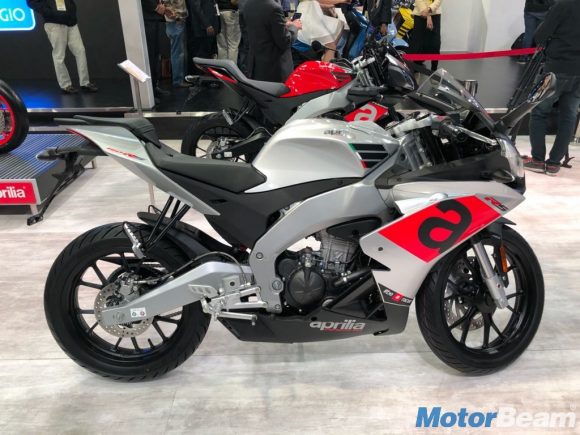Aprilia’s surprise entry into the 150cc segment is bound to create problems for the competition.
Everyone had their eyes set on the 2018 Auto Expo to catch a glimpse of the much-awaited R15 V3 from Yamaha. The stage was set, prices were out but amidst the cheerful atmosphere with people admiring the third-gen R15, the dire lack of ABS was concerning to the more dedicated ones out there. Oh wait, there’s more to come! Peeking from a distance wrapped under Silver Speed livery inspired from the iconic RSV4, the full-faired motorcycle at Aprilia’s stall called the RS 150 caught media attention, and how! The miniature is set to be launched later in the year. How it fares against its arch rival is what this Aprilia RS 150 vs Yamaha R15 V3 comparison is all about.
Design & Looks – As miniature versions of respective brand’s flagship offerings, the two motorcycles are a treat to the eyes. While the R15 V3 wears sharper clothes with a clean stance devoid of cheesy graphics, the RS 150 has the appearance of a track tool on public roads. For the uninformed, the Aprilia will easily pass off as a supersport. The Italian does carry a design flair which is missing in the comparatively mature-looking R15 and, owing to the brand’s newness in the country, will be one heck of an attraction out on the road!
Dimensions – If we talk about numbers, the Aprilia RS 150 is shorter (in length) by 22 mm, wider by 35 mm and about as tall as the R15 V3 at 1135 mm. At 170 mm, the Japanese offering has a higher ground clearance which will help to mitigate the occasional belly scrapes from those so-called ‘speed’ breakers. Also, the R15 has a slightly more accessible seat height (at 815 mm) and 28 mm shorter wheelbase which makes it that much more easier to throw around corners.
Features – Thanks to domestic manufacturers such as Bajaj and TVS who set benchmarks in making tons of features available at delicious prices, Yamaha and Aprilia have come well-prepared with their offerings. Features such as clip-on handlebars, LED tail-lamp, split-seats, disc brakes and rear monoshock suspension come as standard. The Japanese offering also features a wider 140-section rear tyre, slipper clutch, LED headlamps and all-digital cluster but the Aprilia RS 150, equipped with a larger 300 mm front disc, USD forks, ABS and under-belly exhaust, beats its rival hands down considering the price difference! Heck, it even gets the option of a QuickShifter, take that Yamaha!
Powertrain – Powering the Aprilia RS 150 is a 150cc, single-cylinder, fuel-injected motor that churns out 17.83 BHP of power and 14 Nm of torque. On the other hand, the Yammie employs a 155cc VVA engine that develops a class-leading 19.04 BHP of power and 15 Nm of torque. Given the similar kerb weight of the duo, it would be the R15 that will surge ahead when it comes to on-road performance. However, Aprilia has a winning card in the form of its more accommodating 14.5-litre fuel tank that will translate to longer intervals between refueling. In comparison, the R15 comes with an 11-litre fuel tank.
Verdict – Even after 10 years from launch, the Yamaha R15’s magic in the country hasn’t faded one bit. For a reasonable price increment, the R15 V3 is a thorough improvement over the outgoing generation in terms of performance, design and features. Aprilia’s entry into the segment has been marked by the RS 150. Being closely specced to the Yamaha with the addition of ABS and USD forks, the Italian machine is probably as perfect as a 150cc motorcycle can get.
However, Aprilia has a wafer-thin dealer network and the RS 150 costs a fair bit (price based on assumption) which makes it clearly overpriced when viewed in isolation. Sure, the ‘Aprilia’ brand name and associated bragging rights make it an interesting proposition. Having said that, Yamaha would be readying the ABS-equipped R15 V3 by the time Aprilia makes the RS 150 available in India. This move will make the R15 V3 a benchmark once again but till then it’s the RS 150 that leads!

